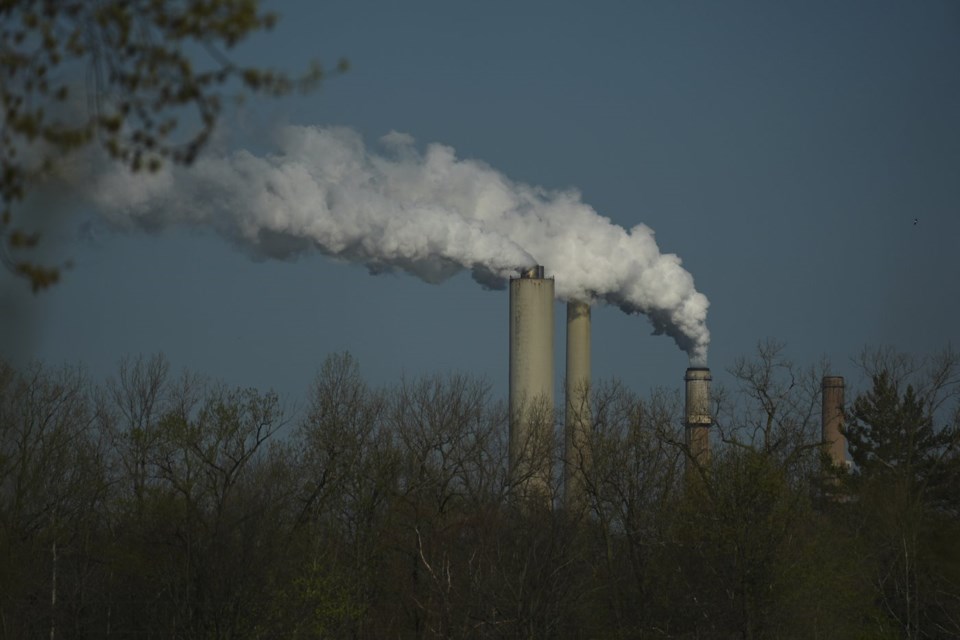WASHINGTON (AP) — Humans are on track to release so much greenhouse gas in less than three years that a key threshold for limiting global warming will be nearly unavoidable, according to a study to be released Thursday.
The report predicts that society will have emitted enough carbon dioxide by early 2028 that crossing an important long-term temperature boundary will be more likely than not. The scientists calculate that by that point there will be enough of the heat-trapping gas in the atmosphere to create a 50-50 chance or greater that the world will be locked in to 1.5 degrees Celsius (2.7 degrees Fahrenheit) of long-term warming since preindustrial times. That level of gas accumulation, which comes from the burning of fuels like gasoline, oil and coal, is sooner than the same group of 60 international scientists calculated in
“Things aren’t just getting worse. They’re getting worse faster,” said study co-author Zeke Hausfather of the tech firm Stripe and the climate monitoring group Berkeley Earth. “We’re actively moving in the wrong direction in a critical period of time that we would need to meet our most ambitious climate goals. Some reports, there’s a silver lining. I don’t think there really is one in this one.”
That , first set in the 2015 Paris agreement, has been a cornerstone of international efforts to curb worsening climate change. Scientists say crossing that limit would mean worse heat waves and droughts, bigger storms and sea-level rise that could imperil small island nations. Over the last 150 years, scientists have established a direct correlation between the release of certain levels of carbon dioxide, along with other greenhouse gases like methane, and specific increases in global temperatures.
In Thursday's report, researchers calculated that society can spew only 143 billion more tons (130 billion metric tons) of carbon dioxide before the 1.5 limit becomes technically inevitable. The world is producing 46 billion tons (42 billion metric tons) a year, so that inevitability should hit around February 2028 because the report is measured from the start of this year, the scientists wrote. The world now stands at about 1.24 degrees Celsius (2.23 degrees Fahrenheit) of long-term warming since preindustrial times, the report said.
Earth's energy imbalance
The report, which was published in the journal , shows that the rate of human-caused warming per decade has increased to nearly half a degree (0.27 degrees Celsius) per decade, Hausfather said. And the imbalance between the heat Earth absorbs from the sun and the amount it radiates out to space, a key climate change signal, is accelerating, the report said.
“It's quite a depressing picture unfortunately, where if you look across the indicators, we find that records are really being broken everywhere,” said lead author Piers Forster, director of the Priestley Centre for Climate Futures at the University of Leeds in England. “I can't conceive of a situation where we can really avoid passing 1.5 degrees of very long-term temperature change.”
The increase in emissions from fossil-fuel burning is the main driver. But reduced particle pollution, which includes soot and smog, is another factor because those particles had a cooling effect that masked even more warming from appearing, scientists said. Changes in clouds also factor in. That all shows up in Earth’s energy imbalance, which is now 25% higher than it was just a decade or so ago, Forster said.
Earth’s energy imbalance “is the most important measure of the amount of heat being trapped in the system,” Hausfather said.
Earth keeps absorbing more and more heat than it releases. “It is very clearly accelerating. It’s worrisome,” he said.
Crossing the temperature limit
The planet temporarily passed the key 1.5 limit . The world hit 1.52 degrees Celsius (2.74 degrees Fahrenheit) of warming since preindustrial times for an entire year in 2024, but the Paris threshold is meant to be measured over a longer period, usually considered 20 years. Still, the globe could reach that long-term threshold in the next few years even if individual years haven't consistently hit that mark, because of how the Earth's carbon cycle works.
That 1.5 is “a clear limit, a political limit for which countries have decided that beyond which the impact of climate change would be unacceptable to their societies,” said study co-author Joeri Rogelj, a climate scientist at Imperial College London.
The mark is so important because once it is crossed, many small island nations could eventually disappear because of sea level rise, and scientific evidence shows that the impacts become particularly extreme beyond that level, especially hurting poor and vulnerable populations, he said. He added that efforts to curb emissions and the impacts of climate change must continue even if the 1.5 degree threshold is exceeded.
Crossing the threshold "means increasingly more frequent and severe climate extremes of the type we are now seeing all too often in the U.S. and around the world — unprecedented heat waves, extreme hot drought, extreme rainfall events, and bigger storms,” said University of Michigan environment school dean Jonathan Overpeck, who wasn't part of the study.
Andrew Dessler, a Texas A&M University climate scientist who wasn't part of the study, said the 1.5 goal was aspirational and not realistic, so people shouldn’t focus on that particular threshold.
“Missing it does not mean the end of the world,” Dessler said in an email, though he agreed that “each tenth of a degree of warming will bring increasingly worse impacts.”
___
The Associated Press’ climate and environmental coverage receives financial support from multiple private foundations. AP is solely responsible for all content. Find AP’s for working with philanthropies, a list of supporters and funded coverage areas at .
Seth Borenstein, The Associated Press



